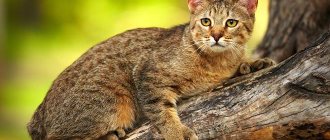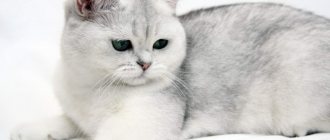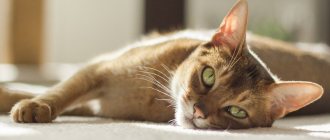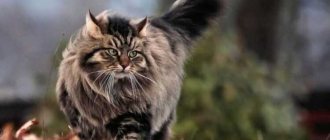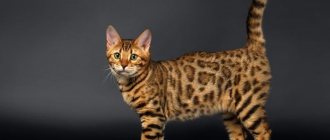Bengal cat or Bengal cat, leopard in your home
The Bengal cat or Bengal cat is distinguished by its fur, identical to that of a leopard, it is distinguished by the presence of spots or rosettes that have dark tones on the outside and are golden and brown on the inside.
The coat of this cat breed can be of different colors, among which orange, gold, ivory, cream, blue and black stand out. It is a fairly robust feline, of medium size and with a rather thick tail. The price of these cats ranges from 900 to 2500 euros in certified catteries.
Cost of a kitten
Toygers are a new breed that is still in development. To make the cat look more like a toy tiger, breeders try to give cats its features: a wide nose, rounded ears, light areas of the belly and chest.
Kittens born with color irregularities or too long hair lose the opportunity to participate in exhibitions, but retain the character of their breed, which is why they become excellent companions.
Rarity explains the reason for the high cost of toygers:
- Pet class - from fifty thousand rubles.
- Breed class - about two hundred thousand.
- Show class - up to two hundred thousand.
A kitten purchased from a nursery will belong to the pet class, so it will be sterilized before being handed over to the owner. When purchasing, it is recommended to check the pedigree and vaccinations.
Toyger cat, a tiger-like cat
Toyger cats are also known as "tiger cats" and have a very thick and long tail with many black stripes. The fur of these cats has shades of gold, yellow and orange, and is also thick and short.
This is a fairly active cat and loves to explore, play, run, walk and jump from place to place. The price of Toyger cat ranges from 1000 to 1600 euros, but if it is intended for breeding, the cost increases to approximately 3500-5000 euros.
Conditions for keeping
Keeping brindle cats is not burdensome. Short-haired animals are combed once a week with a rubber mitten. Scottish and British cats have a thick undercoat that actively sheds twice a year, so the animals need to be brushed more often. A furminator can handle this task. The same rule applies to Siberian cats. Their luxurious fluffy coat sheds profusely in the spring and during the heating season. Tools such as a slicker and the same furminator will come to the rescue.
Breeders recommend giving the cat its own corner in the house, placing a house or bed there, as well as a scratching post. In addition, animals are given a place to litter and eat.
Bath days are organized twice a year. However, you should also remember that most cats are not happy about bathing. For example, the Scots and British are afraid of water like fire, but toygers and begals, on the contrary, love to swim. Therefore, it is important to take into account the characteristics of each breed and not force your pet.
The diet is selected depending on the breed, taking into account the recommendations of veterinarians.
Toygers inherited good health from their ancestors and experts do not give any special recommendations on nutrition.
Bengals should be fed natural high-protein foods or premium dry and wet food.
Tender Sokoke require a balanced diet fortified with taurine and vitamin E due to heart problems and metabolic disorders.
Mau are prone to allergies, asthma and heart disease, so they need special fortified food. Pet stores have lines of dry and wet food with a balanced composition that can maintain animal health.
It is recommended to feed Savannah with natural products: beef, poultry, ocean white fish, and give dry food as an addition to the main diet.
American Shorthairs, Scottish Shorthairs and British Shorthairs love to eat and are prone to weight gain. Therefore, animals need to be fed twice a day, and periodically pampered with boiled chicken breast.
Siberian cats need a balanced diet. For 1 kg of weight they give 30-60 g of feed. To maintain the beauty of their coat, cats under 3 years of age are given food containing 70% protein.
Savannah, domestic serval
The Savannah cat has fur like a leopard or tiger, with an amber-orange tint and black dots and stripes. This cat is curious, active and very active; it is very similar to a wild cat, although its character resembles a domestic cat.
Likewise, it can reach a weight of approximately 25 kg and its dimensions can reach up to 60 cm in height. The Savannah price is around 2800 and 7000 euros.
Breed character and habits
Toyger is a good companion. Has a peaceful character. He easily finds a common language with children, as well as cats and dogs with whom he lives in the same area.
Kittens are very active. To prevent them from ruining things, it is worth buying a special gaming complex. Some kids make hiding places, so you don’t need to be surprised if any little thing goes missing. With age they become calmer.
Cats are always ready to brighten up loneliness. However, they understand perfectly well when the owner wants to be left alone. They do not chase a person, demanding affection and attention. Despite their devotion, they calmly endure forced separation.
Kittens are very active
Animals are playful and patient; children often become their playmates. The pet will not hurt the child - it will not scratch or bite, so kids can safely trust the “mustachioed nannies.”
Young animals are prone to manipulation. Sometimes they do mischief on purpose so that the owner will pay attention to them.
Cats feel good both in a private house and in a small apartment. They quickly adapt to environmental conditions. Animals jump well.
It will not be difficult for them to climb onto a high shelf or mezzanine. But they act very carefully - they do not catch or drop things.
Mini-tigers cannot be called first-class hunters. But active games and imitation of catching prey are part of their daily leisure time. If the owner disappears for days at work, he should take care of entertainment for his pet.
Toyger rarely speaks. He does not harass the owner with obsessive meowing.
Ocicat, domestic jaguar
Tiger-like cats called Ocicats have very fine fur with spots and stripes reminiscent of wild cats. Its main characteristic is its strong and fairly muscular body.
They have a rounded head with a slight prominence running from the bridge of the nose to the forehead. Ocicat can be found at prices ranging from 600 to 1400 euros.
Pros and cons of the breed
The advantages and disadvantages of toygers are presented in the table:
| Advantages | Flaws |
| Original appearance | High price |
| Friendly character | Tendency to obesity |
| Get along with other pets | |
| Low maintenance | |
| Cleanliness | |
| Good learning ability | |
| Good health |
Egyptian Mau
This cat breed is medium in size, has a fairly strong body, and also has very well developed muscle mass. This is a cat native to Egypt, where it was once considered a sacred cat.
A distinctive feature of this feline is her agility, she is also very affectionate and quite territorial. The price of these tiger-like cats ranges from 1,000 to 3,000 euros.
Breeding
Toygers are bred by professionals. Individuals have the right to position their own kittens as “pets.”
Large catteries operating under the Judy Sugden system sell cats with breeding rights only to reputable breeders. The remaining animals are spayed or neutered.
Before sale, a breeding inspection is carried out, where their thoroughbred is confirmed.
Mating and partner selection
Breeders carefully select partners, trying to emphasize certain traits. The breed is difficult to work with. It takes decades to fix the parameters.
Crossing Toyregs with other breeds is prohibited. The resulting kittens are subject to culling and sterilization.
Pregnancy and childbirth
Toygers tolerate pregnancy and childbirth well. Gestation lasts about 65 days. In a litter, the female brings 4-5 kittens.
Breeders carefully select partners, trying to emphasize certain traits
Chausie
Its build is muscular and strong and it has a coat of different colors such as silver, dark grey, black tabby or brown tabby with brown and buff tones.
The ears are slanted and pointed, the fur is very short, and the legs are quite long. It can weigh at least 10 kg and is very similar to a wild cat. At home he is very restless and somewhat destructive. Its price ranges from 1000 to 2000 euros.
Characteristics of this breed
There are several features inherent in mini-tigers:
- Toygers know no fear. They may jump out the window in pursuit of a bird, or boldly approach the neighbor's shepherd dog.
- Like real tigers, they are not afraid of water. They often shower with their owners.
- They don't like confined spaces. They are difficult to transport in a carrier or basket.
- Capable of purring in different tones. This is how they express their mood and feelings.
Shedding
The fur practically does not fall out. Combing becomes not a mandatory procedure, but a pleasant massage.
Allergy
The breed is considered hypoallergenic. Due to weak shedding, the fur practically does not spread throughout the home.
Vaccinations
To maintain your pet's health, you should adhere to the vaccination schedule previously agreed upon with your veterinarian.
The first vaccination occurs at the age of two to three months. Then, in the second or third week after the procedure, revaccination is done.
The next vaccination is given when the pet reaches one year and is repeated annually.
10 days before the planned vaccination, deworming is carried out.
Health
Typically, wild-type animals are very resilient and disease-resistant, unlike their bred counterparts. Modern genetic studies have shown that the T gene, which determines the brindle color, is directly related to immunity.
Artificially created breeds, more than the descendants of their “wild” counterparts, are susceptible to diseases such as:
- cardiomyopathy;
- cardiac hypotrophy;
- cataract;
- feline leukemia.
The rest of the “tiger cubs” mostly suffer only from the same diseases that ordinary domestic cats suffer from:
- colds;
- infections;
- poisoning
Catering
A balanced and high-quality diet is a must if you want to raise your pet healthy and strong.
But food from your own plate is not suitable: fried, smoked, sweet foods are death for a cat's stomach. You will have to follow a number of rules. Don't be afraid: there is nothing complicated about them.
Natural products
When choosing natural food, follow the recommendations of the breeder and veterinarians. Both of them strongly recommend not feeding the animal salty and sweet dishes, pickled foods, baked goods, citrus fruits, and sweets (chocolate is strictly prohibited).
List of permitted products:
- lean meats: beef, veal, rabbit, turkey, rabbit;
- fish: flounder, hake, salmon, trout, cod;
- dairy and fermented milk products: low-fat cottage cheese, sour cream, yogurt, cream, natural yogurt;
- vegetables: zucchini, pumpkin, carrots, broccoli, asparagus, green salad;
- cereals: buckwheat, rice, millet, oatmeal, pearl barley;
- purified drinking water (temperature comfortable for the animal).
The presence of dyes, GMOs, artificial and chemical components in food is not allowed.
Recommended food
You can also feed your cat commercial food. Modern food is affordable and formulated taking into account all the basic needs of the animal.
Experienced breeders advise buying food from holistic groups: Primordial, Pronature Holistic, Savarra. Super premium: Naturea, Vigor & Sage, Vet Life. The rest (premium and economy class) have a poor composition and too many questionable components in the composition (for example, artificial preservatives, flavor enhancers, etc.).
Below are recommended super-premium foods. Links with the names of the food are clickable, on them you can, within our website, get acquainted with the descriptions of the food and read reviews from owners of Toyger cats.
| Holistic | Super premium | Super premium |
| Riverwood | Optima Nova | Monge |
Mating
Despite the fact that Bengals took an active part in the development of the Toyger breed, crossing with them is prohibited at the legislative level.
Judy Sugden, the creator of domestic mini-tigers, insists on castration of males. This is due to the fact that work is still underway to improve the breed.
Registered nurseries work closely with Judy. Working on adopting a more accurate brindle color and maintaining a friendly disposition.
Despite their predatory appearance, toygers are harmless. They adore their owners with all their cat soul. Devoted. Attentive. Pet tigers will become an integral part of the family. The center of attention. An excellent reason to rush home to your striped friend.
Diseases
No genetic diseases have been identified in this breed, and no serious diseases have been reported either. The most your pet can suffer from is a common cold. Therefore, make sure that the animal does not lie in a draft and does not freeze after bathing.
Vaccinations are required if you love your pet and want him to be healthy. Even if you do not let your cat go for walks, pathogens can easily be brought home on your own hands (if you stroke the animal with unwashed hands), but on the soles of shoes or street clothes.
Rabies, rhinotracheitis, panleukopenia, calcivirosis are deadly diseases from which the animal must be protected. Currently, there are a number of complex vaccines (which contain not one, but several components), which are administered from an early age (6-10 weeks). Repeated vaccinations are given once a year. Popular vaccines on the domestic market: Nobivak (Tricket and Forcat), Quadrikat, Leukorifelin, Multifel-4, Fel-O-vax), Primucel.
Expert opinion
Dusheba Vera Ivanovna
In 2010, she graduated from the Moscow State Academy of Veterinary Medicine named after K.I. Scriabin with honors, specializing in veterinary medicine. I regularly attend veterinary conferences, congresses, and webinars.
Before vaccination, be sure to give your cat anthelmintic medications. But not human ones - they will cause poisoning! - and special ones, for animals. Before purchasing the drug, be sure to consult your doctor. It is impossible to drive worms from pregnant cats (in the first half of the term), in the presence of infectious diseases, pathologies of the urinary system and liver, as well as in kittens under 6 weeks of age.
Origin of brindle color
Tabby cats have existed since ancient times. Since ancient times, it was believed that these animals attract good luck, so they enjoyed great success and respect. Tiger cats are natives of the New World and belong to the subfamily of small cats. They are characterized by large eyes, a large body and grayish or yellowish striped fur with black streaks. Experts distinguish 3 types of tiger cats:
- southern tiger;
- northern brindle;
- leopard spotted.
All of them are considered wild and differ from each other in the length and color of their coat.
Application
Toygers become equal members of the family and everyone's favorites. Exotic appearance and affectionate character can melt even the coldest hearts.
In addition, European and American breeders finance charitable foundations. The activities of these organizations are aimed at preserving the tiger population in their natural habitat.


